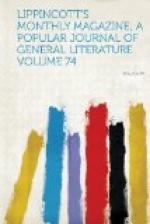“Ah! there you are; and what a capital likeness!” cried Edgar, with the joyous look and accent of one meeting an old friend, giving that gauge of interest which we all unconsciously give when we first see the photograph of a well-known face. He looked at the portrait long and critically. “Only not so pretty,” he added gallantly. “Those fellows cannot catch the spirit: they give only the outside forms, and not always these correctly. Here is a striking face,” he continued, pointing to Adelaide’s companion-picture—a girl with masses of dark hair, dark eyes, large, mournful, heavily fringed with long lashes, and a grave, sad face, that seemed listening rather than looking. “Who is she? She looks foreign.”
Adelaide glanced at the page, as if she did not know it by heart. “That? Oh! that is only Leam Dundas,” she said with the faintest, finest flavor of scorn in her voice.
“Leam Dundas?” repeated Edgar—“the daughter of that awful woman?”
“Yes, and nearly as odd as the mother,” answered Adelaide, still in the same cold manner and with the same accent of superior scorn.
“At least she used to be, you mean, dear, but she is more like other people now,” said kindly Josephine, more just than politic.
Adelaide looked at her calmly, indifferently. “Yes, I suppose she is rather less savage than of old,” was her reply, “but I do not see much of her,”
“I do not remember to have ever seen her: she must have been a mere child when I was here last,” said Edgar.
“She is nineteen now, I think,” said Mrs. Harrowby.
“Not more?” repeated Adelaide. “I imagined she was one-and-twenty at the least. She looks so very much older than even this—five or six and twenty, full; dark people age so quickly.”
“She seems to be superbly handsome,” Edgar said, still looking at the portrait.
“For those who like that swarthy kind of beauty. For myself, I do not: it always reminds me of negroes and Lascars.”
Adelaide leaned forward, and made pretence to examine Leam’s portrait with critical independence of judgment. She spoke as if this was the first time she had seen it, and her words the thought of the moment resulting.
“There is no negroid taint here,” Edgar answered gravely. “It is the face of a sibyl, of a tragedian.”
“Do you think so? It is fine in outline certainly, but too monotonous to please me, and too lugubrious; and the funny part of it is, there is nothing in her. She looks like a sibyl, but she is the most profoundly stupid person you can imagine.”
“Not now, Addy: she has wakened up a good deal,” again interposed Josephine with her love of justice and want of tact.
“But do you not see the mother in her, Josephine? I do, painfully; and the mother was such a horror! Leam is just like her. She will grow her exact counterpart”
“A bad model enough,” said Edgar; “but this face is not bad. It has more in it than poor old Pepita’s. How fat she was!”




